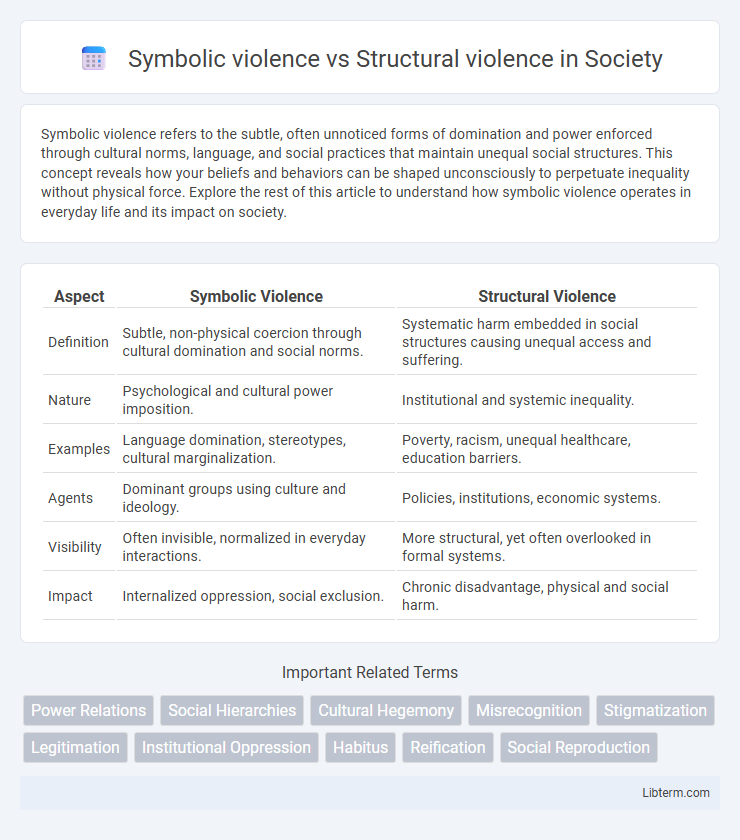Symbolic violence refers to the subtle, often unnoticed forms of domination and power enforced through cultural norms, language, and social practices that maintain unequal social structures. This concept reveals how your beliefs and behaviors can be shaped unconsciously to perpetuate inequality without physical force. Explore the rest of this article to understand how symbolic violence operates in everyday life and its impact on society.
Table of Comparison
| Aspect | Symbolic Violence | Structural Violence |
|---|---|---|
| Definition | Subtle, non-physical coercion through cultural domination and social norms. | Systematic harm embedded in social structures causing unequal access and suffering. |
| Nature | Psychological and cultural power imposition. | Institutional and systemic inequality. |
| Examples | Language domination, stereotypes, cultural marginalization. | Poverty, racism, unequal healthcare, education barriers. |
| Agents | Dominant groups using culture and ideology. | Policies, institutions, economic systems. |
| Visibility | Often invisible, normalized in everyday interactions. | More structural, yet often overlooked in formal systems. |
| Impact | Internalized oppression, social exclusion. | Chronic disadvantage, physical and social harm. |
Understanding Symbolic Violence: Definition and Characteristics
Symbolic violence refers to the subtle, often unnoticed forms of coercion embedded in cultural norms, language, and social practices that perpetuate power imbalances and social hierarchies without physical force. It functions through symbolic means such as ideology, education, and media, which naturalize and legitimize domination by shaping perceptions and internalizing inequality among dominated groups. These characteristics distinguish symbolic violence from structural violence, which involves systemic and institutionalized harm impacting individuals' basic needs and well-being.
Defining Structural Violence: Key Concepts and Examples
Structural violence refers to systematic ways in which social structures harm or disadvantage individuals, often embedded in institutions like education, healthcare, and legal systems. Key concepts include inequality, social injustice, and institutionalized oppression that restrict people's access to resources and opportunities. Examples include racial discrimination in housing policies, economic disparity caused by wage gaps, and limited healthcare access in marginalized communities.
Historical Origins of Symbolic and Structural Violence
Symbolic violence, a concept developed by sociologist Pierre Bourdieu, originates from the ways cultural dominance and power are maintained through everyday social practices, often unconsciously reinforcing inequality. Structural violence, traced back to Johan Galtung's work in the 1960s, refers to systematic ways in which social structures harm or disadvantage individuals by preventing access to resources, rights, or opportunities. Both forms of violence are rooted in historical contexts of colonialism, class oppression, and institutionalized discrimination that shape societal power dynamics.
Mechanisms of Symbolic Violence in Society
Symbolic violence operates through mechanisms such as linguistic domination, cultural norms, and internalized beliefs that perpetuate power imbalances without overt physical harm. It enforces social hierarchies by normalizing inequality through education, media, and everyday interactions, making domination seem natural or justified. These subtle, pervasive processes sustain structural violence by embedding oppression within the symbolic order of society.
Manifestations of Structural Violence in Institutions
Structural violence manifests in institutions through systemic inequalities embedded in policies and practices that disadvantage marginalized groups. Examples include disparities in access to quality education, healthcare inequities, discriminatory hiring practices, and unequal legal protections. These institutional barriers perpetuate social stratification and limit opportunities for affected populations, reinforcing long-term socioeconomic disadvantages.
Intersections Between Symbolic and Structural Violence
Symbolic violence, characterized by the internalization of dominant cultural norms that legitimize inequality, intersects with structural violence through systemic social, political, and economic arrangements that perpetuate harm and exclusion. This intersection manifests when symbolic violence reinforces structural barriers, such as racial discrimination and class oppression, embedding inequality deeply into everyday practices and institutions. Understanding these overlaps highlights how power operates invisibly, sustaining social hierarchies and hindering equitable access to resources and opportunities.
Social Impact: Consequences for Marginalized Communities
Symbolic violence perpetuates social hierarchies by embedding domination and inequality into everyday interactions, reinforcing marginalized communities' internalized oppression and limiting their social mobility. Structural violence manifests through institutional policies and systemic inequalities that restrict access to resources, healthcare, education, and economic opportunities for marginalized groups. Both forms of violence collectively sustain social exclusion, exacerbate poverty, and hinder empowerment, deepening disparities within affected populations.
Power Dynamics: Who Perpetuates and Who Suffers?
Symbolic violence is perpetuated by dominant social groups who impose cultural norms and values that legitimize their power, while marginalized individuals internalize these norms, leading to self-discrimination and compliance. Structural violence is embedded in institutional systems and policies, maintained by those in positions of authority or economic control, causing widespread harm to disadvantaged populations through inequality and restricted access to resources. Both forms of violence reinforce power imbalances, with suffering primarily experienced by oppressed groups lacking social, economic, or political influence.
Strategies for Addressing Symbolic and Structural Violence
Addressing symbolic and structural violence requires targeted strategies such as promoting inclusive education that challenges dominant cultural narratives and dismantles stereotypes perpetuating symbolic violence. Policy reforms aimed at equitable resource distribution, legal protections against discrimination, and community empowerment initiatives can mitigate structural violence by altering institutional practices and power dynamics. Collaborative efforts between governments, civil society, and marginalized groups enhance accountability and foster systemic change to reduce both symbolic and structural forms of violence.
Towards Social Justice: Building Inclusive and Equitable Systems
Symbolic violence manifests through subtle, often unnoticed cultural impositions that maintain social inequalities by shaping perceptions and legitimizing domination. Structural violence refers to systemic inequalities embedded in social, political, and economic institutions that hinder access to resources and opportunities for marginalized groups. Building inclusive and equitable systems requires addressing both symbolic violence and structural violence through transformative policies and community empowerment to foster social justice.
Symbolic violence Infographic

 libterm.com
libterm.com